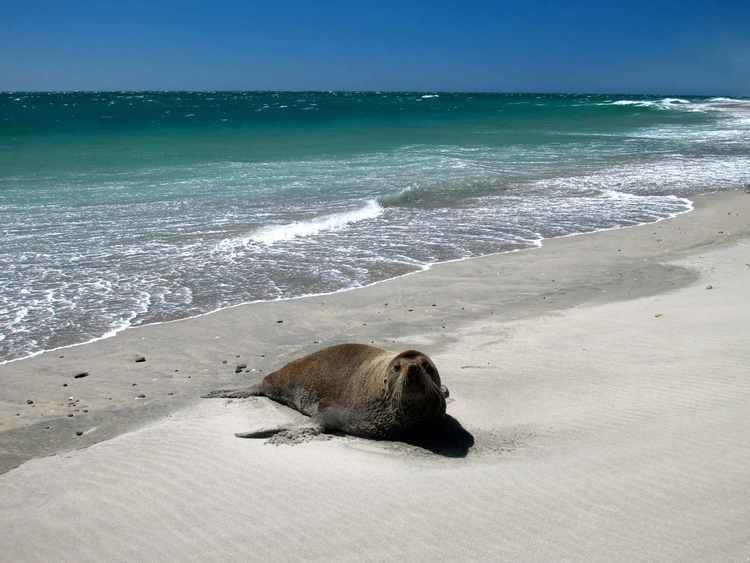 | ||
Similar Wharariki Beach, Abel Tasman National, Te Waikoropupū Springs, Kahurangi National Park, Heaphy Track | ||
Farewell Spit is a narrow sand spit at the northern end of the Golden Bay, South Island of New Zealand. Known to the Māori as Tuhuroa, it runs eastwards from Cape Farewell, the island's northernmost point. It is located about 50 kilometres north of Takaka and 20 kilometres from Collingwood. The tiny settlement of Puponga stands close to the western (landward) end of the spit.
Contents
Map of Farewell Spit, 7073, New Zealand
It forms the northern side of Golden Bay and is the longest sandspit in New Zealand, stretching for about 26 km above sea level and another 6 km underwater. The spit runs in from west to east, and is made from fine golden sand – as Cape Farewell to the west of the spit is mostly composed of late Cretaceous quartz sandstones, i.e. silica but with traces of other heavy minerals, garnet, ilmenite, magnetite and pyroxene. The erosion of the cliffs into fine sand carried on the sea currents creates Farewell spit further east.
The northern side of the dunes are steeper and unstable being constantly exposed to the prevailing winds which average over 25 km/h. The southern side which faces Golden Bay is more stable and largely covered with vegetation. The tide here can recede as much as seven kilometres exposing some 80 square kilometres of mud flats; a rich feeding ground for the many sea birds in the area but also a trap for frequently stranded whales.
Human use
Abel Tasman in 1642 was the first European to see the spit, calling it Sand Duining Hoeck. Captain James Cook was the next European visitor in 1770, showing Farewell Spit as a broad peninsula on his maps. He named close by Cape Farewell, and the name stuck, with early European settlers originally calling the sandbanks 'Cape Farewell Spit' before it was shortened to its present name. It was the last land he sighted after leaving New Zealand for Australia at the end of his first voyage.
The lighthouse at the end of the spit was first lit on 17 June 1870 in response to many ships having been wrecked upon the spit. The original timber tower did not stand up well to the frequent blasting by the sand and salt-laden winds experienced at the end of the spit. The hardwood used started to decay rapidly and the original tower was replaced in 1897 by the present structure, the only steel latticework lighthouse in New Zealand.
Due to the spit only reaching 30 metres (98 ft) above sea level at this point, the lighthouse has to be taller than usual for New Zealand's coast. The light of the 27 metres (89 ft) tall tower can be seen for 35 kilometres (22 mi). The original oil-burning lamp was converted to a 1000 watt electric lamp in 1954, and the diesel power supply replaced by a buried mains electricity cable along the spit in 1966. The original lamp was changed to a modern rotation beacon with a 50 tungsten halogen bulb in 1999.
The light was fully automated and the last lighthouse keeper was withdrawn in 1984. The lighthouse keeper's house and two accommodation buildings are still being maintained for use by the Department of Conservation, Maritime New Zealand, and tour groups.
The spit is administered by the New Zealand Department of Conservation as a sea bird and wild life reserve. Apart from a small area at the base of the Spit it is closed to the public except through organised tours.
Four-wheel drive bus tours from Collingwood or Puponga include the opportunity to jump off a sand dune, a visit to the lighthouse and the gannet colony. The south side of Farewell Spit is home to many thousands of sea birds; it also the site of frequent whale strandings mainly by Long-Finned Pilot Whales. The northern side is bounded by the Tasman Sea.
Shipwrecks
The Queen Bee ran aground off Farewell Spit in 1877 and the SS Port Kembla was sunk by a mine 17 km off the spit in 1917.
Whale stranding
Whale strandings have been a common occurrence throughout history on Farewell Spit. On 15 November 2012, a pod of pilot whales stranded themselves on the spit, around two kilometres north-east from the Spit Cafe. Eleven were found dead on the first day. The spit has claimed around 680 Whales since records began. In January 2014 several whales stranded and re-stranded. This included a pod of 50 pilot whales, many of whom died from stress or needed to be euthanised despite several attempts to refloat them. In February 2015, pilot whales were found stranded on Farewell Spit. On 10 February 2017 a pod of 416 pilot whales beached overnight at Farewell Spit. 75% of the whales were dead upon the arrival of a Project Jonah medical rescue team and attempts were undertaken to refloat the remaining live whales at the morning high tide. Efforts are underway, but 240 more arrived on Saturday.
